U.S. Department of Transportation
Federal Highway Administration
1200 New Jersey Avenue, SE
Washington, DC 20590
202-366-4000
Federal Highway Administration Research and Technology
Coordinating, Developing, and Delivering Highway Transportation Innovations
|
Research & Technology Transporter This newsletter is an archived publication and may contain dated technical, contact, and link information. |
|
| Publication Number: N/A Date: September 1996 |
Publication Date: September 1996
|
Last Updated: 9/2/96
| Federico F. Peña Secretary, U.S. Department of Transportation |
| Rodney E. Slater Administrator, Federal Highway Administration |
| Jane F. Garvey Deputy Administrator, Federal Highway Administration |
| RTCG CHAIRPERSONS |
|---|
| Bud Wright--Safety Stan Gordon--Structures Jim Scapellato--Motor Carriers Paul Teng--Pavements Gary Euler--ITS Bob Ford--International Barna Juhasz--Policy, Planning, Environment, Information Management & Right-of-Way |
| Anne Barsanti, Managing Editor Jon Schans, Editor Zac Ellis, Editor |
An ongoing FHWA project has researchers at Oak Ridge National Laboratory (ORNL) developing fuel consumption and emission models for TRAF-NETSIM. They will update the fuel consumption and emission rates for light-duty vehicles currently being used by the model. In the early 1980's, ORNL developed the currently used fuel consumption tables based on testing 15 light-duty vehicles. Emission tables for carbon monoxide, hydrocarbons, and oxides of nitrogen were generated based on the testing of only 6 of the 15 vehicles. The current project will develop and update fuel consumption and emission tables based on eight vehicles, which are the 1988 Chevrolet Corsica, 1994 Oldsmobile Cutlass Supreme, 1994 Oldsmobile Eighty Eight, 1994 Mercury Villager Van, 1995 Geo Prizm, 1994 Jeep Grand Cherokee, 1994 Chevrolet Silverado Pickup, and 1993 Subaru Legacy.
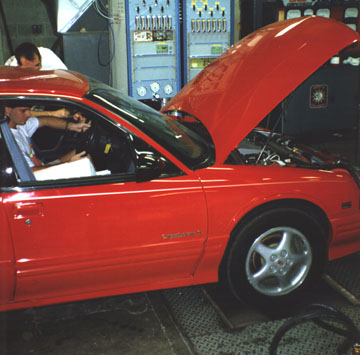
A vehicle being tested for emissions and fuel consumption.
The look-up tables for fuel consumption and emissions are developed by characterizing the vehicles' performance both on road and on a chassis dynamometer, over all of the vehicle/engines' operating range. The vehicle's engine parameters are measured during transient and steady-state on-road testing. The on-road tests are conducted on public roads and on an airport runway near Oak Ridge. Emissions and fuel consumption are then measured as functions of the same engine parameters on a chassis dynamometer at the nearby University of Tennessee in Knoxville. The two data sets are merged numerically to deliver models of fuel consumption and emissions as functions of vehicle speed and acceleration. The resultant tailpipe emission models comprise a composite of steady-state and transient conditions, and thereby represent the average emissions at any given operating point.
The results of this effort will be used to update the look-up tables currently included in TRAF-NETSIM. Armed with its new lookup tables, TRAF-NETSIM will be better equipped to evaluate the impact of traffic control strategies on fuel consumption and air quality at the project level.
-- Aladdin Barkawi
The FHWA/NHTSA National Crash Analysis High Performance Computing Lab at the George Washington University's Virginia Campus provides researchers in automotive and roadside hardware safety with access to some of the most powerful, sophisticated computer systems available. The facility, created through funding from FHWA, the National Highway Traffic Safety Administration (NHTSA), and the George Washington University, is ranked in the upper half of the computer industry's "Top 500" list of the world's most powerful supercomputer facilities. The facility, which was started in 1993 to study the application of parallel processing to car crash simulation, doubled its capacity in early 1996 with the acquisition of a second parallel processing system.
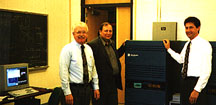
Representatives from FHWA's Office of Safety and Traffic Operations visit NCAC's supercomputers.
Taking advantage of recent advances in supercomputer technology, the dual Silicon Graphics Power Challenge XL supercomputer system is the most powerful in the world dedicated to crash analysis. The computer is used to develop new and improved designs of roadside hardware as well as assess vehicle to vehicle crashes. Researchers at the National Crash Analysis Center (NCAC) have direct access to this system capable of solving very large crash simulation problems. Problems which required a month of computer processing time on a workstation can be solved overnight using the parallel processing capabilities. A network of high-end graphics workstations, which is used to support research on advanced visualization techniques, permits users to visualize simulation results.
A dedicated high-speed phone connection between FHWA's Turner-Fairbank Highway Research Center (TFHRC) and NCAC's supercomputer facility provides researchers at FHWA with direct access to this supercomputer system. Access to the system is also provided to participants in the FHWA university grants program, making it possible for researchers in the program to use the highly complex full-scale vehicle models being developed at NCAC.
-- Leonard Meczkowski (202) 493-3317
From June 7 to 12, 1996, Dr. Richard Livingston of FHWA's Exploratory Research Team, traveled to Heraklion on the island of Crete to attend the Fifth International Conference on the Applications of Neutrons in Research and Industry. He presented a paper on the preliminary results of research using neutron scattering to study the process of portland cement hydration. This project is a collaboration between TFHRC and the Cold Neutron Research Facility at the National Institute of Standards and Technology (NIST) in Gaithersburg, Maryland.
The neutron scattering technique makes it possible to non-destructively test and carefully measure the details of the hydration process through which the portland cement develops its strength. The work is revealing that the hydration reaction has a complex dependence on temperature and mixing conditions. The data will be used to develop a mathematical model of the process, which can form the basis for an improved prediction of the strength development of portland cement concrete (PCC).
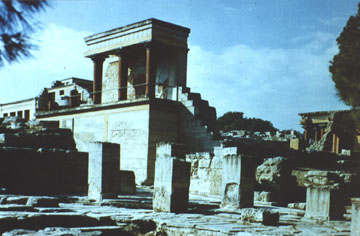
The Palace of Knossos, circa 1600 B.C., becomes a source of data for concrete researchers.
The conference covers all aspects of the use of neutrons. It is held every other year in Crete. Among the major topics of applications presented at this year's conference were cancer treatment, materials science, and explosives detection. Several papers on air plane baggage inspection concerned projects funded by FAA. Some of this technology could be applied to the neutron scattering studies of concrete that FHWA is exploring. Therefore, a collaboration in this area between FAA's Atlantic City Technical Center and TFHRC is being pursued. Another speaker at the conference, Hank Prask, described research on the use of neutron diffraction to non-destructively study the strain in steel. TFHRC is also collaborating with NIST to apply this technique to the investigation of fatigue in aging bridge steel.
The Palace of Knossos is of interest to concrete researchers for several reasons. It is built with blocks of alabaster (gypsum) rather than the conventional limestone or sandstone, and early this century was restored with PCC. Over time, the concrete in contact with the gypsum has reacted in a deterioration process that resembles the cement/sulfate reaction that is now becoming a major concern to the concrete industry. Finally, the concrete was made with a natural pozzolanic rock that may improve certain properties of concrete. Thus, the long-term effects of pozzolanic additions to PCC can also be investigated at Knossos. Negotiations are underway with Greek scientists for collaboration on this research.
-- Dick Livingston (202) 493-3063
Version 6.0 of the microcomputer program HYDRAIN has been distributed to FHWA field offices and to State highway agencies. HYDRAIN was originally developed under a contract with GKY & Associates, through a pooled-fund study with 41 States. The HYDRAIN consists of a program shell, editor, and six hydraulic engineering programs. Their applications are:
| Program Name | Application |
|---|---|
| NFF | USGS Regression Equations |
| HYDRO | Hydrology |
| STORM DRAIN PROGRAM | Storm drain systems |
| HYCHL | Roadside channels |
| WSPRO | Water surface profiles and bridge hydraulics |
| HY8 | Culverts, hydrographs, routing, and energy dissipators |
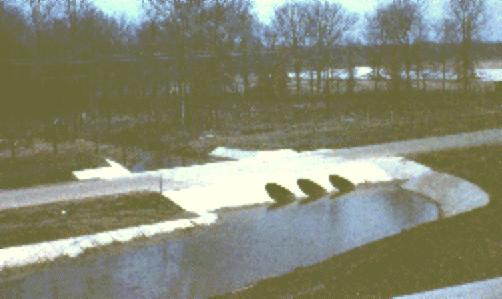
Culverts and channels are among the types of hydraulic structures that can be designed or analyzed using HYDRAIN 6.0.
Since the completion of the pooled-fund study developed through the Office of Engineering R&D's Structures Division, FHWA's Bridge Division and Office of Technology Applications (OTA) have supported improvements and enhancements to HYDRAIN, including the development of version 6.0, which offers the following significant new features and methodologies:
Hands-on training for HYDRAIN 6.0 is available from the National Highway Institute (NHI) under Course #13057. The HYDRAIN 6.0 software and users manual will be made available to the public through the software distribution center at McTrans (352-392-0378) and PC-TRANS (913-864-5655).
-- For more information on FWHA's Hydraulics software see: www.fhwa.dot.gov/engineering/hydraulics/software.cfm.
You can't open a newspaper or magazine, watch television, or look at advertisements, it seems, without seeing references to the Internet and the World Wide Web. We in Government are no exception to the bombardment of news about the Net. OTA has been exploring how the office may use the worldwide network to its advantage.
Last summer, OTA began asking the question "Why use the Internet?" We provided some basic Internet training office-wide and obtained several dial-up connections so we could all explore and determine what the opportunities might be. As a result of this, we came up with some pretty good answers for what we wanted the Internet to do for us. We see the Internet doing three things:
Make our Projects Better--The Internet, by its nature of providing global access and information, provides our project managers with access to resources like never before. Also, since e-mail and global communications are as easy as clicking a mouse, new networks will develop.
Help us Promote our Activities and Projects--The Internet will benefit us by making our projects more visible. As FHWA's technology transfer arm, showcasing our technologies on the Internet naturally complements our current promotional activities. Using this tool, we can expand our customer base while providing a new link with our current customers. This aspect alone makes the Internet a good match for OTA. OTA has already ventured into this world by developing a home page.
Collaboration--The Internet can be the platform that allows us to exchange ideas and share different perspectives in a controlled way. One means is through the use of software on the Internet that allows us to have a "rolling dialogue," or conversation, with a controlled group of participants on specialized topics. With this feature, we can post an issue that a group is interested in, and participants can post their reaction, comments, or ideas. Overall, this should allow us to more easily share our insights and draw a group together into a more productive unit.
We view OTA's use of the Internet as an on-line, multi-media communications tool that markets our technologies, adds value to users by being a technology resource, and broadens our ability to disseminate information, including public outreach, in a faster and potentially cheaper way. This is especially true in the area of on-line publishing and receiving customer feedback. Comments on the OTA home page can be sent to Cliff Mosley.
-- Mike Burk (202) 366-8033
Nelda Bravo of OTA has begun serving a 1-year term as Chair of the Transportation Division of the Special Libraries Association (SLA). SLA is an international association of more than 15,000 information professionals and special librarians from institutions that use or produce information in such areas as business, science, research, Government, and academia. One of Nelda's primary duties as Chair will be to prepare for the SLA Annual Meeting to be held in Seattle in June 1997. She has selected two session topics--sustainable transportation and preserving the historical record in the electronic age--and has begun getting speakers. Nelda is also setting up discussion groups on emerging information technologies.
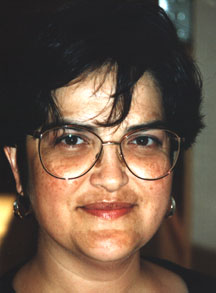
Chairperson Nelda Bravo hopes to strengthen the ties between LTAP Centers and transportation libraries.
The 1996 SLA Annual Meeting that was held in Boston from June 5 to 8 brought together more than 7,300 information professionals and over 500 vendors. Lisa Pogue and Clare Maaseide staffed a booth for FHWA's Local Technical Assistance Program (LTAP), a national network of 57 technology transfer centers that provides State and local governments with access to highway technology and information. They answered questions and exchanged publication lists with information specialists from the American Association of State Highway and Transportation Officials, Transportation Research Board, American Public Works Association, State highway agencies, transportation research institutes, and other transportation organizations.
As the LTAP Program Officer, Nelda sees a natural relationship between the LTAP Centers and the transportation libraries, noting that "both are involved in overlapping aspects of technology transfer and information exchange." Nelda hopes to use her position as Chair of the SLA Transportation Division to strengthen the relationship.
-- Nelda Bravo (202) 366-9633
NHI's Course #13064, Bridge Engineering, continues to be well received by bridge engineers. The first week of the third course was presented from May 6-10, 1996, in Schaumburg, Ill. The Illinois DOT Bridge Engineer, Ralph Anderson, requested that the course be split into four separate weeks and participants be allowed to attend the entire course or only selected weeks if they so choose. This has obviously generated renewed interest in the course as 79 participants from the private sector, academia, State, and local and Federal Government agencies attended.
The course is taught by 29 of the Nation's leading bridge engineers and provides comprehensive coverage of all aspects of highway bridge engineering. The exceptionally high quality of instruction is the leading comment received from the participants. When one of the participants who attended the very first course was asked to comment on the most beneficial aspect, she responded without hesitation, "I now know all the right people!"
The remaining schedule for the Illinois course is Week 2: September 9 - 13, 1996; Week 3: May 5 - 9, 1997; and Week 4: September 8 - 12, 1997. Following close behind and overlapping this course is one to be sponsored by the Florida DOT in Tallahassee, Florida, with the following schedule: Week 1: October 7 - 11, 1996; Week 2: January 20 - 24, 1997; Week 3: April 21 - 25, 1997; and Week 4: June 9 - 11, 1997 (subject to change).
To register for either course or for more information, including information on sponsoring the course in your area, call the Principal Instructor, Bob Nickerson (410) 374-5276 or Larry Jones at NHI on (703) 235-0523.
-- Larry Jones (703) 235-0523

The handbook is an invaluable reference for administrators, traffic engineers, transportation planners, and students.
The 1996 edition of the Traffic Control Systems Handbook (Publication No. FHWA-SA-95-032) is now available. The new handbook updates the 1985 edition and serves as a basic reference for planning, designing, and implementing effective traffic control systems. The handbook incorporates the latest Intelligent Transportation Systems (ITS) technologies and concepts. Another feature of the new handbook is A Look to the Future section in selected chapters describing systems and elements currently being developed. Thus, the handbook points to the evolving state of the art for traffic control systems, as well as summarizes the existing state of the practice. Copies of the handbook have been distributed to FHWA regional and division offices. Additional copies may be obtained from the R&T Report Center by calling (301) 577-0906 or faxing (301) 577-1421.
-- John McCracken (202) 366-2219
FHWA is the primary sponsor of the Second National Conference on Women's Travel Issues. The conference will be held October 23-26 in Baltimore. It will focus on the travel patterns, needs, and attitudes of women and their families. The purposes of the conference are to review relevant research over the 18-year period since the first conference on this topic, evaluate the planning and policy implications of these findings, and identify areas in need of additional study.

The conference will focus on the travel patterns, needs, and attitudes of women and their families.
The conference will cover a wide range of issues, including women's labor force participation and distance to work; women, accidents, and alcohol; neighborhoods and non-work travel; women and transit security, and the biomechanics of women and accidents. Dr. Sandra Rosenbloom of the University of Arizona and Dr. Shirley Byron of Morgan State University are the conference co-chairs. For more information, contact the Drachman Institute at the University of Arizona, (520) 623-1223. Information is also available at the Web site (http://w3.arizona.edu/~drachman/wm_trvl/wm_trvl.htm).
-- Elaine Murakami (202) 366-6971